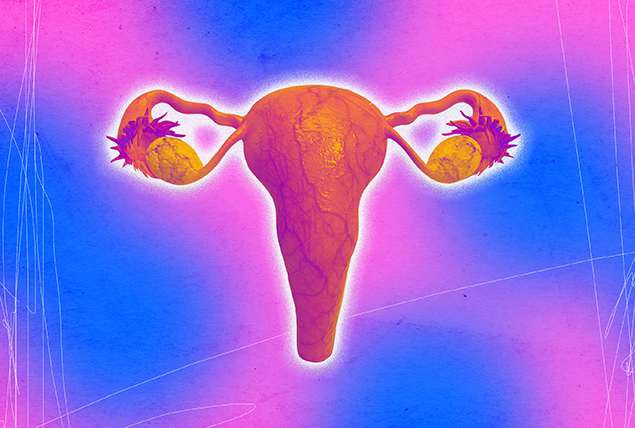Bleeding Backward: What Is Retrograde Menstruation?

Although retrograde menstruation sounds like a rare astronomical occurrence, it's often a normal part of the menstrual process. You may have heard conflicting information or been told not to invert during a yoga class while on your period. Get the facts.
What happens during retrograde menstruation?
During a menstrual period, the uterus sheds its lining, called the endometrium, through the cervix and vagina. In retrograde menstruation, blood and tissue flow backward through the fallopian tubes and the pelvis.
"Usually, this doesn't cause any symptoms, but some may report a lighter-than-usual period. The most common symptom associated with retrograde menstruation is pain during the period," explained Eve Lepage, M.S.N., a registered nurse with a background in reproductive health and a science writer at Clue, a period and pregnancy tracking app company based in Berlin.
Retrograde menstruation is not a condition or disease.
"We think of it as a normal part of having a period, in fact, most people won't even know it's happening," explained Adiele Hoffman, B.Sc., M.B.B.S., a general practitioner for the National Health Service in the United Kingdom and a medical advisor at Flo Health, a women's health app. "In most people, it's not a big deal, and the blood that enters the pelvis just gets absorbed by your body."
Symptoms and causes of retrograde menstruation
"Retrograde menstruation is common; as many as 9 in 10 people with open fallopian tubes have it to some degree," Lepage said.
Despite its prevalence, little is known about the direct cause of retrograde menstruation, Lepage explained. There's no substantial, conclusive research on the possible causes.
"Retrograde menstruation is usually not a medical concern. It only becomes a concern if it causes painful symptoms or is associated with a condition like endometriosis," Lepage said. "Retrograde menstruation isn't typically diagnosed as a condition on its own. It may be discovered during an evaluation for pelvic pain or endometriosis. Your healthcare provider may perform a laparoscopy during menstruation, a procedure to look inside your abdomen, and discover blood."
Someone might not know they're experiencing retrograde menstruation because it is so common and usually not concerning. Unless it's spotted through diagnostic testing for another condition, you won't typically find out.
Retrograde menstruation and endometriosis
In the 1920s, gynecologist John A. Sampson, M.D., proposed the theory of retrograde menstruation as a cardinal reason for the pathogenesis, or development, of endometriosis. The theory posited that endometrial tissue entered the abdominal wall, leading to endometriosis, which is the growth of endometrial-like tissue outside the uterus.
The theory was well-received, although research on endometriosis was scant. The cause of endometriosis is still unclear, however, most research that involves retrograde menstruation is conducted through endometriosis research.
"In some people, we think some of the cells in period blood stick to the fallopian tubes, ovaries or other parts of the pelvis. The theory is that this causes endometriosis, which happens when tissue similar to the uterine lining is found in other places in the body," Hoffman said. "In most people, it won't cause any problems at all. You won't even know it's happening. But if the cells from the uterine lining do stick to parts of the pelvis, endometriosis may result."
Most people who menstruate may experience retrograde menstruation, but not everyone goes on to develop endometriosis.
More about endometriosis
"Endometriosis is a condition in which endometrial-like tissue, like the tissue that lines the uterus, grows in areas outside the uterus, typically on and around the organs in the pelvic cavity," Lepage said.
The disease can cause "painful periods, difficulty becoming pregnant and other symptoms, like pain during sex and painful bowel movements," Lepage said.
Endometriosis is also fairly common, affecting about 1 in 10 women of reproductive age, Lepage said.
"Some scientists believe retrograde menstruation can increase the risk of endometriosis because the endometrial tissue that flows back can implant and grow outside the uterus, causing pain, inflammation and scarring," Lepage added.
Immune system cells may play a role in normalizing retrograde menstruation and absorbing stray uterine lining, explained Lone Hummelshoj, chief executive of the World Endometriosis Society, in a 2014 Slate report.
Not all research supports the idea that retrograde menstruation causes endometriosis.
"Retrograde menstruation is common, and most people don't develop endometriosis. Research has shown that there are likely multiple factors involved in the development of endometriosis," Lepage added.
Retrograde menstruation is not a definitive cause of endometriosis.
Treatment and diagnosis
Treatment is not needed for retrograde menstruation on its own.
"As it can be a normal part of menstruation, it doesn't usually need any treatment unless you're getting problems like painful periods or endometriosis," Hoffman said.
For endometriosis, treatment can involve pain management, hormonal therapies to block ovulation and stop the period, or surgery to remove endometriotic tissue, Lepage said.
If you have concerns about your health, schedule an appointment with your doctor.
"Some pain during menstruation is normal. However, if you're experiencing painful periods that are impacting your daily life, nausea, vomiting or dizziness, or notice changes to your period volume, length or regularity, it's important to speak to your healthcare provider so they can rule out any underlying medical cause," Lepage said.
Never hesitate to contact your healthcare professional if your period seems different.
The bottom line
Retrograde menstruation is not typically a cause for concern or a reason to not invert in yoga class while on your period. It's a generally regular bodily occurrence. But when menstruation interferes with everyday life, it's always best to reach out to your doctor.


















